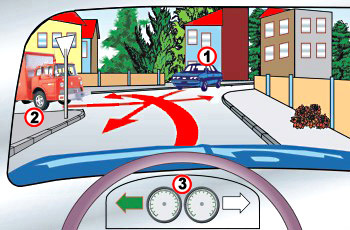Question:1
A 17yr. old Israeli born citizen applies for a driving license.Which physician is certified to perform a medical examination for his application?
Category : Rules and Regulations
Question:2
From the answers before you, where especially should a driver slow down?
Category : Rules and Regulations
Question:3
What is a reasonable vehicle speed?

Category : Rules and Regulations
Question:4
When the vehicle in front of you signals about its intention to turn left:
Category : Rules and Regulations
Question:5
Can a person drive a vehicle immediately after taking medications which have effect on his fitness to drive?
Category : Rules and Regulations
Question:6
According to the following picture, is it permitted to make a U-turn?

Category : Rules and Regulations
Question:7
What is a special taxi ride?
Category : Rules and Regulations
Question:8
Is it obligatory to obey the directions of a Public Works Department employee in uniform?
Category : Rules and Regulations
Question:9
How should you behave at the following intersection (the red vehicle is not an emergency vehicle)?

Category : Rules and Regulations
Question:10
What would you do if your driving lane is obstructed?
Category : Rules and Regulations
Question:11
When driving behind a slow vehicle on a roadway while a continuous centre white line is marked to your left:
Category : Rules and Regulations
Question:12
What is a “security vehicle”?
Category : Rules and Regulations
Question:13
When may a driver be in possession of only photocopies of his original vehicle documents?
Category : Rules and Regulations
Question:14
Is it permitted to drive a heavy vehicle when the air pressure in the braking system is below the required minimum?
Category : Rules and Regulations
Question:15
It is permitted to park, stop or stand a vehicle when the distance between the vehicle’s wheels and the road’s edge doesn’t exceed:
Category : Rules and Regulations
Question:16
In the following illustration you can see a wide road. Which of the numbers within the illustration marks a road way?

Category : Rules and Regulations
Question:17
A policeman may stop a vehicle and have it checked:
Category : Rules and Regulations
Question:18
When you exit a dirt road on to a paved road.
Category : Rules and Regulations
Question:19
The following illustration shows an intersection with traffic signs. What is the correct manner of making a turn from street A to street C?

Category : Rules and Regulations
Question:20
When is it permitted to overtake another vehicle on its rights side?
Category : Rules and Regulations
Question:21
Is it obligatory to install a tachograph on a route service bus?
Category : Rules and Regulations
Question:22
Is a policeman authorized to require a vehicle driver to undergo a blood test for the presence of alcohol or intoxicating drugs?
Category : Rules and Regulations
Question:23
Who is responsible for a vehicle emitting smoke above statutory levels?
Category : Rules and Regulations
Question:24
When is it lawfully required to perform a vehicle license test?
Category : Rules and Regulations
Question:25
The correctional measures which may be imposed by the Licensing Authority, based on the point system:
Category : Rules and Regulations
Question:26
When you are standing with your vehicle before an intersection while the red light is on, and you notice a security vehicle behind you, with its siren on and its lights flashing:
Category : Rules and Regulations
Question:27
Is a taxi driver permitted to load passengers within the limits of signs that prohibit stopping or parking?
Category : Rules and Regulations
Question:28
Where should vehicles drive in a road divided by a Central divider?

Category : Rules and Regulations
Question:29
Is it permitted to park a vehicle on the left side of a two-way street?
Category : Rules and Regulations
Question:30
What types of vehicles are permitted to park in a bus station, besides the bus itself?
Category : Rules and Regulations

